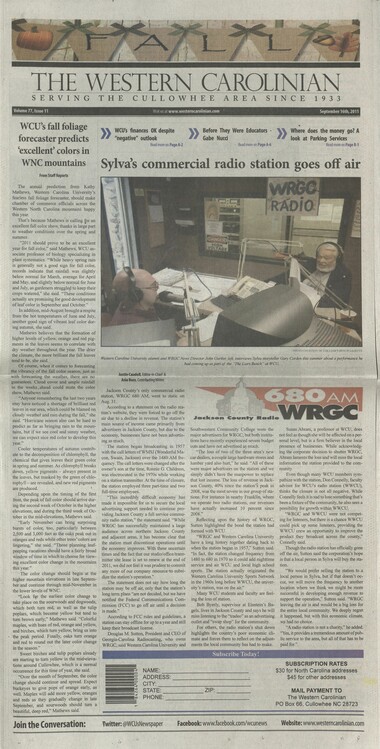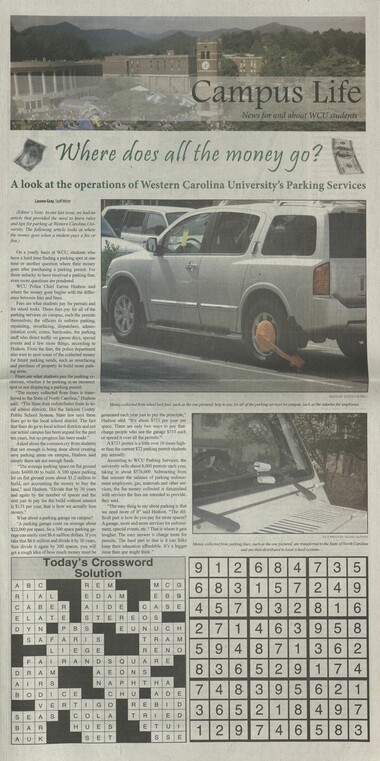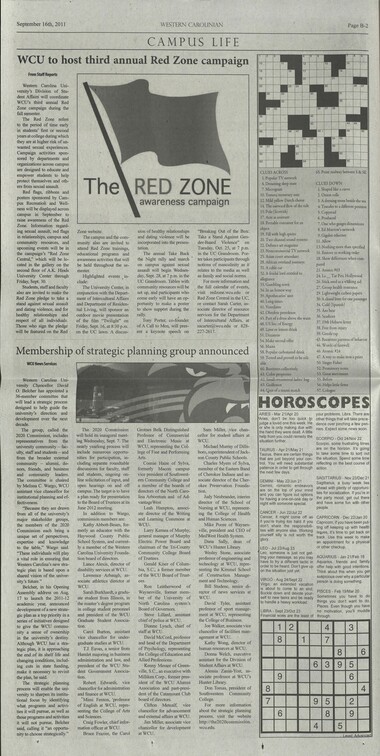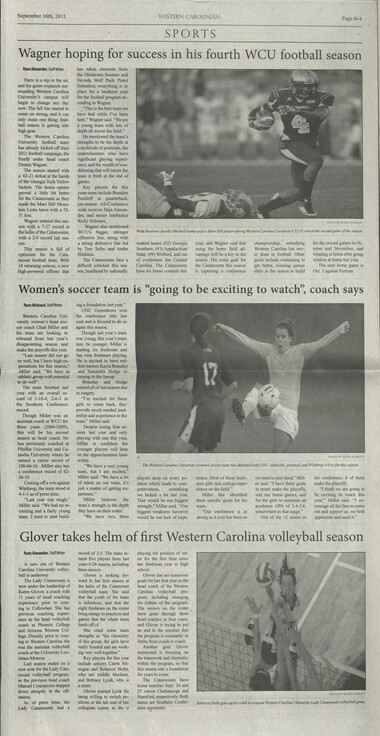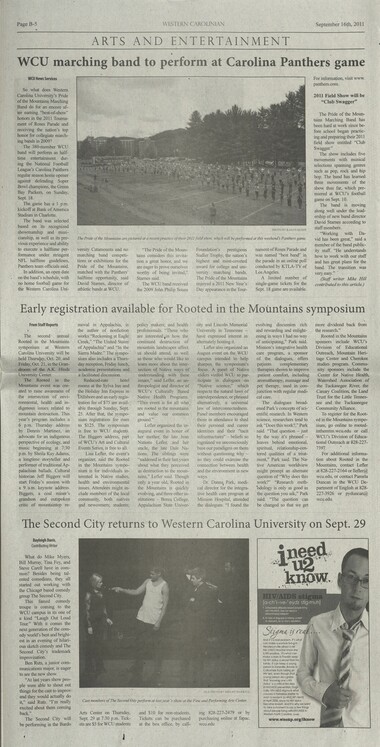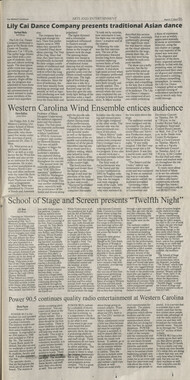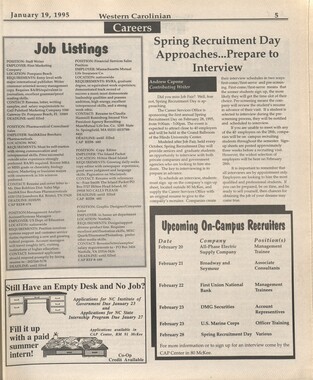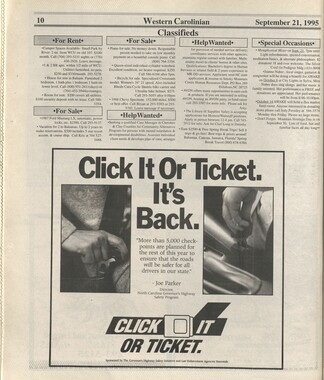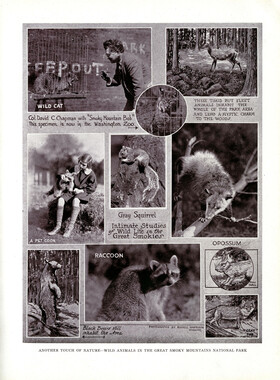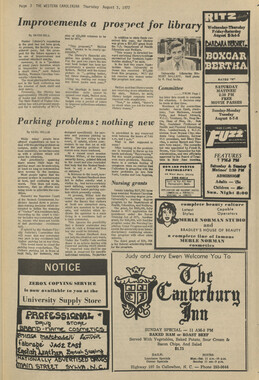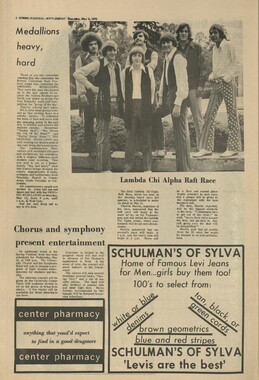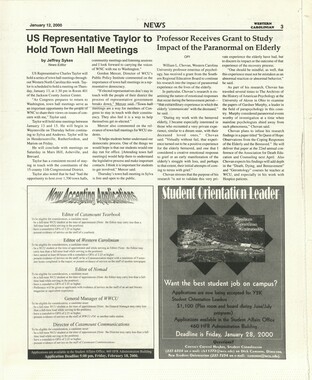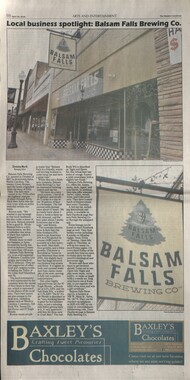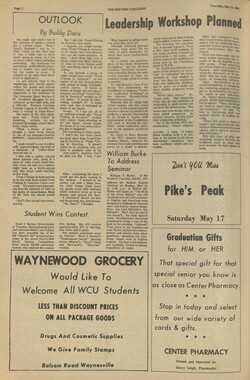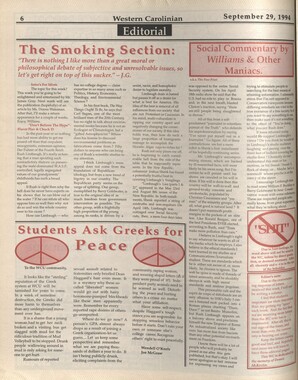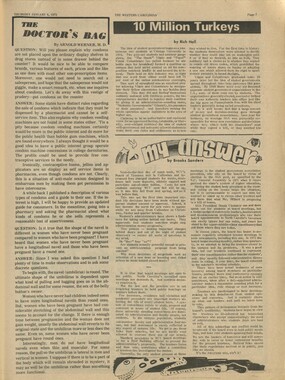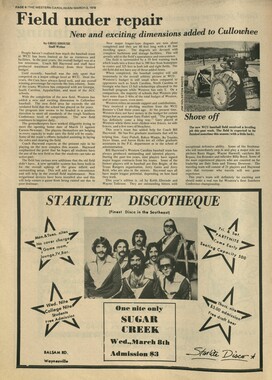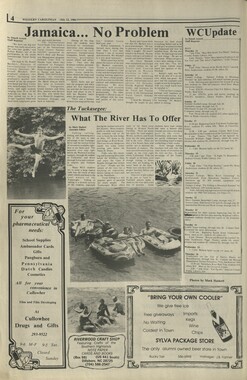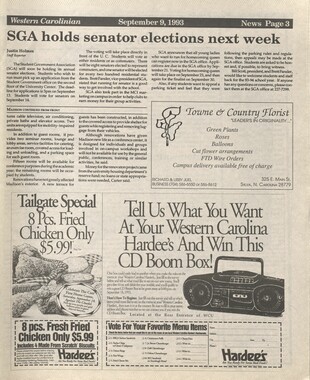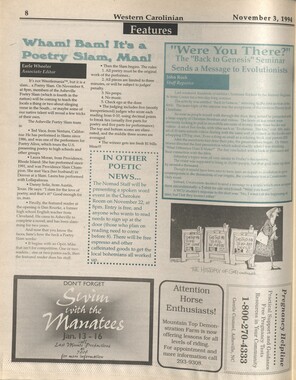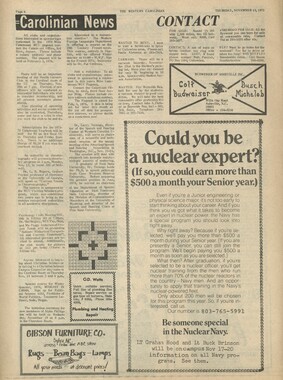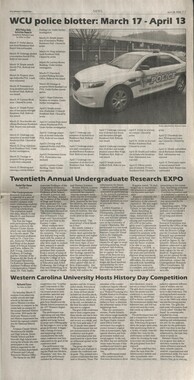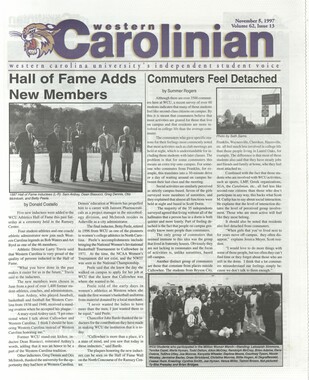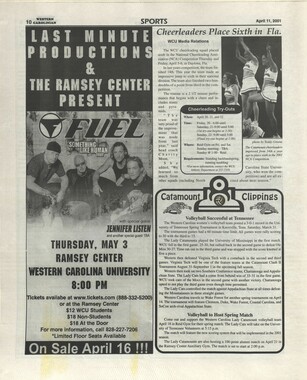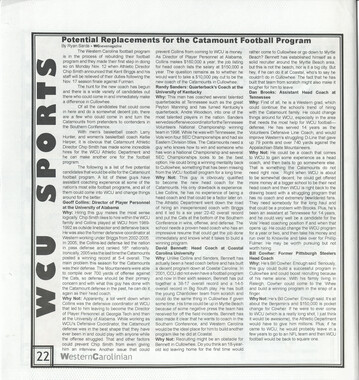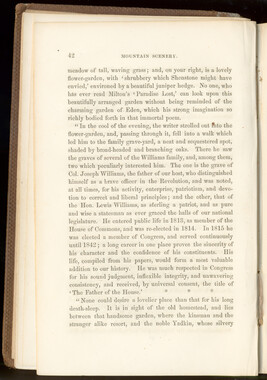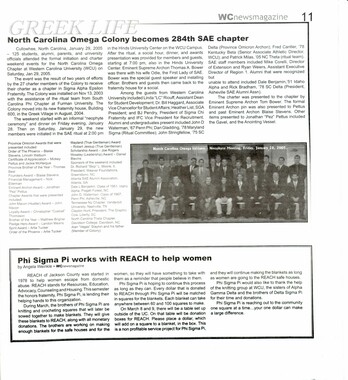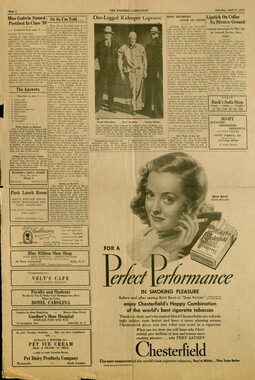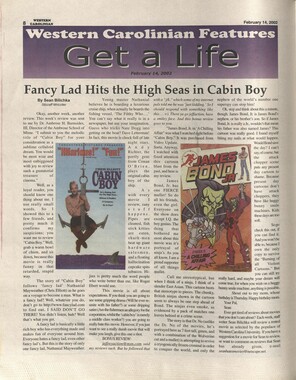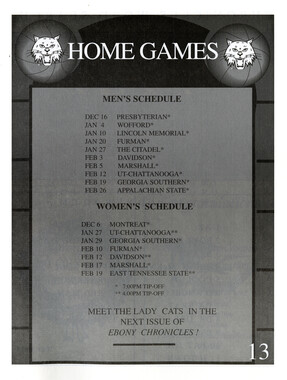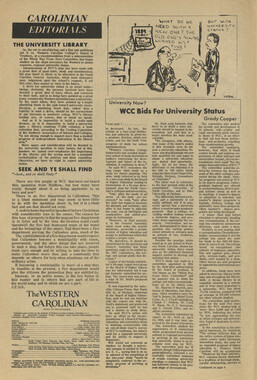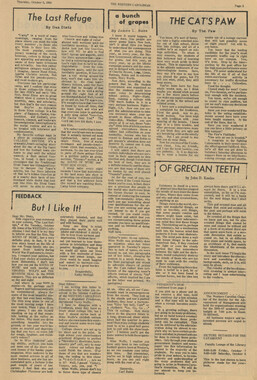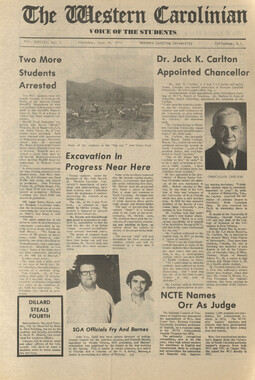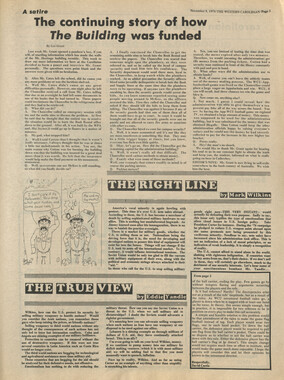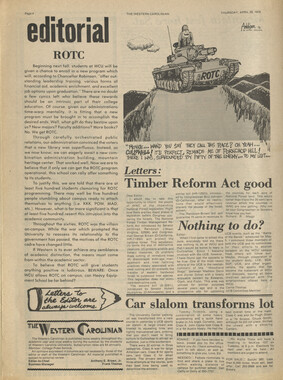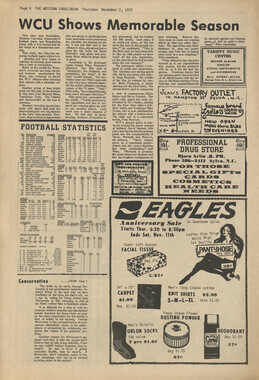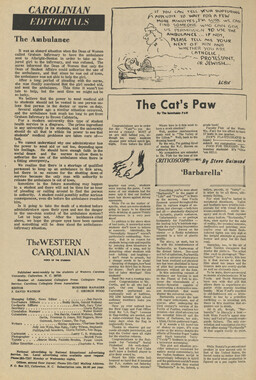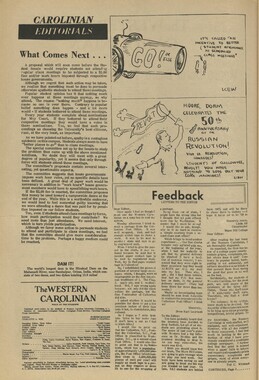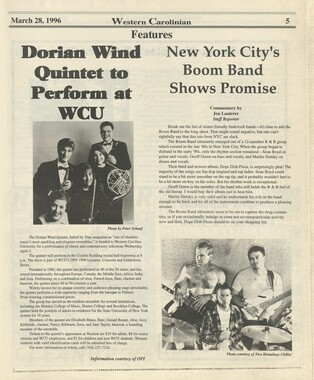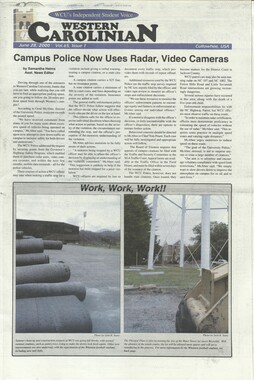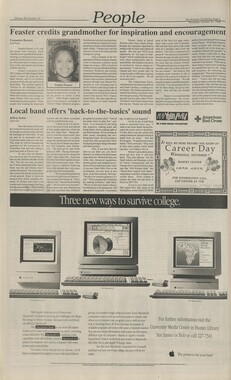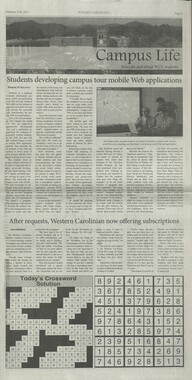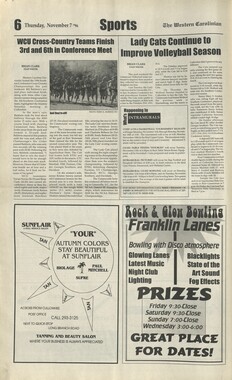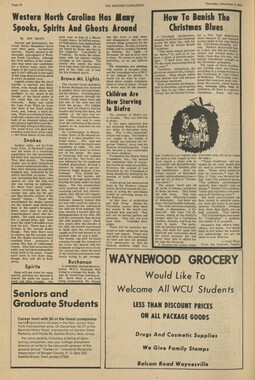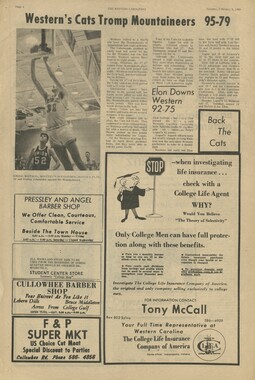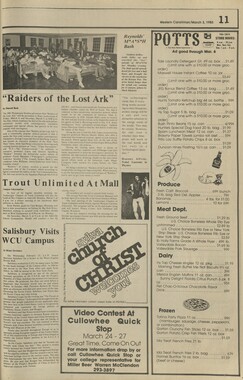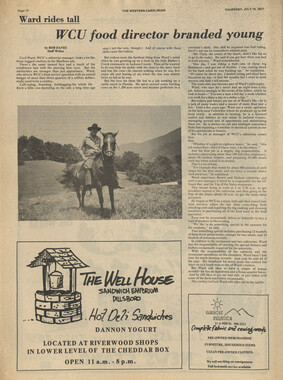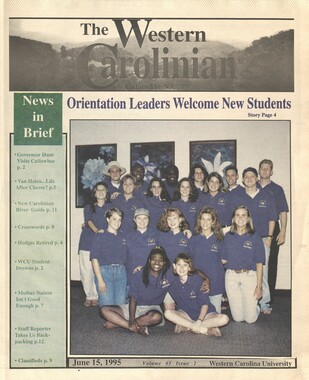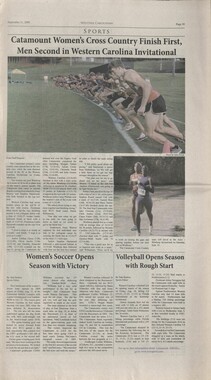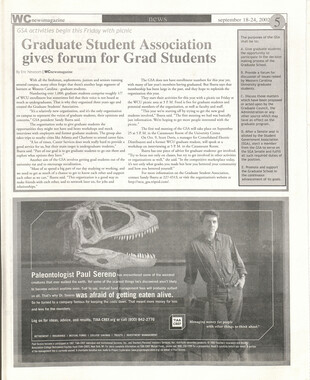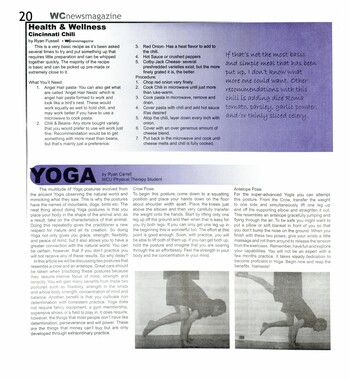Western Carolina University (21)
View all
- Canton Champion Fibre Company (2308)
- Cherokee Traditions (291)
- Civil War in Southern Appalachia (165)
- Craft Revival (1942)
- George Masa Collection (137)
- Great Smoky Mountains - A Park for America (2900)
- Highlights from Western Carolina University (422)
- Horace Kephart (973)
- Journeys Through Jackson (159)
- LGBTQIA+ Archive of Jackson County (85)
- Oral Histories of Western North Carolina (316)
- Picturing Appalachia (6797)
- Stories of Mountain Folk (413)
- Travel Western North Carolina (153)
- Western Carolina University Fine Art Museum Vitreograph Collection (129)
- Western Carolina University Herbarium (92)
- Western Carolina University: Making Memories (738)
- Western Carolina University Publications (2491)
- Western Carolina University Restricted Electronic Theses and Dissertations (146)
- Western North Carolina Regional Maps (71)
- World War II in Southern Appalachia (131)
University of North Carolina Asheville (6)
View all
- Allanstand Cottage Industries (62)
- Appalachian National Park Association (53)
- Bennett, Kelly, 1890-1974 (1463)
- Berry, Walter (76)
- Brasstown Carvers (40)
- Carver, George Washington, 1864?-1943 (26)
- Cathey, Joseph, 1803-1874 (1)
- Champion Fibre Company (233)
- Champion Paper and Fibre Company (297)
- Cherokee Indian Fair Association (16)
- Cherokee Language Program (22)
- Crowe, Amanda (40)
- Edmonston, Thomas Benton, 1842-1907 (7)
- Ensley, A. L. (Abraham Lincoln), 1865-1948 (275)
- Fromer, Irving Rhodes, 1913-1994 (70)
- George Butz (BFS 1907) (46)
- Goodrich, Frances Louisa (120)
- Grant, George Alexander, 1891-1964 (96)
- Heard, Marian Gladys (60)
- Kephart, Calvin, 1883-1969 (15)
- Kephart, Horace, 1862-1931 (313)
- Kephart, Laura, 1862-1954 (67)
- Laney, Gideon Thomas, 1889-1976 (439)
- Masa, George, 1881-1933 (61)
- McElhinney, William Julian, 1896-1953 (44)
- Niggli, Josephina, 1910-1983 (10)
- North Carolina Park Commission (105)
- Osborne, Kezia Stradley (9)
- Owens, Samuel Robert, 1918-1995 (11)
- Penland Weavers and Potters (36)
- Roberts, Vivienne (15)
- Roth, Albert, 1890-1974 (142)
- Schenck, Carl Alwin, 1868-1955 (1)
- Sherrill's Photography Studio (2565)
- Southern Highland Handicraft Guild (127)
- Southern Highlanders, Inc. (71)
- Stalcup, Jesse Bryson (46)
- Stearns, I. K. (213)
- Thompson, James Edward, 1880-1976 (226)
- United States. Indian Arts and Crafts Board (130)
- USFS (683)
- Vance, Zebulon Baird, 1830-1894 (1)
- Weaver, Zebulon, 1872-1948 (58)
- Western Carolina College (230)
- Western Carolina Teachers College (282)
- Western Carolina University (2008)
- Western Carolina University. Mountain Heritage Center (18)
- Whitman, Walt, 1819-1892 (10)
- Wilburn, Hiram Coleman, 1880-1967 (73)
- Williams, Isadora (3)
- Cain, Doreyl Ammons (0)
- Crittenden, Lorraine (0)
- Rhodes, Judy (0)
- Smith, Edward Clark (0)
- Appalachian Region, Southern (2940)
- Asheville (N.C.) (1944)
- Avery County (N.C.) (26)
- Blount County (Tenn.) (195)
- Buncombe County (N.C.) (1680)
- Cherokee County (N.C.) (283)
- Clay County (N.C.) (556)
- Graham County (N.C.) (238)
- Great Smoky Mountains National Park (N.C. and Tenn.) (525)
- Haywood County (N.C.) (3573)
- Henderson County (N.C.) (70)
- Jackson County (N.C.) (4919)
- Knox County (Tenn.) (35)
- Knoxville (Tenn.) (13)
- Lake Santeetlah (N.C.) (10)
- Macon County (N.C.) (421)
- Madison County (N.C.) (216)
- McDowell County (N.C.) (39)
- Mitchell County (N.C.) (135)
- Polk County (N.C.) (35)
- Qualla Boundary (982)
- Rutherford County (N.C.) (78)
- Swain County (N.C.) (2185)
- Transylvania County (N.C.) (270)
- Watauga County (N.C.) (12)
- Waynesville (N.C.) (86)
- Yancey County (N.C.) (72)
- Aerial Photographs (3)
- Aerial Views (60)
- Albums (books) (4)
- Articles (1)
- Artifacts (object Genre) (228)
- Bibliographies (1)
- Biography (general Genre) (2)
- Cards (information Artifacts) (38)
- Clippings (information Artifacts) (192)
- Copybooks (instructional Materials) (3)
- Crafts (art Genres) (622)
- Depictions (visual Works) (21)
- Design Drawings (1)
- Digital Moving Image Formats (2)
- Drawings (visual Works) (185)
- Envelopes (101)
- Exhibitions (events) (1)
- Facsimiles (reproductions) (1)
- Fiction (general Genre) (4)
- Financial Records (12)
- Fliers (printed Matter) (67)
- Glass Plate Negatives (381)
- Guidebooks (2)
- Internegatives (10)
- Interviews (817)
- Land Surveys (102)
- Letters (correspondence) (1045)
- Manuscripts (documents) (618)
- Maps (documents) (177)
- Memorandums (25)
- Minutes (administrative Records) (59)
- Negatives (photographs) (6090)
- Newsletters (1290)
- Newspapers (2)
- Notebooks (8)
- Occupation Currency (1)
- Paintings (visual Works) (1)
- Pen And Ink Drawings (1)
- Periodicals (193)
- Personal Narratives (10)
- Photographs (12976)
- Plans (maps) (1)
- Poetry (6)
- Portraits (4568)
- Postcards (329)
- Programs (documents) (181)
- Publications (documents) (2444)
- Questionnaires (65)
- Relief Prints (26)
- Sayings (literary Genre) (1)
- Scrapbooks (282)
- Sheet Music (2)
- Slides (photographs) (402)
- Songs (musical Compositions) (2)
- Sound Recordings (796)
- Specimens (92)
- Speeches (documents) (18)
- Tintypes (photographs) (8)
- Transcripts (324)
- Text Messages (0)
- A.L. Ensley Collection (275)
- Appalachian Industrial School Records (7)
- Appalachian National Park Association Records (336)
- Axley-Meroney Collection (2)
- Bayard Wootten Photograph Collection (20)
- Bethel Rural Community Organization Collection (7)
- Blumer Collection (5)
- C.W. Slagle Collection (20)
- Canton Area Historical Museum (2110)
- Carlos C. Campbell Collection (462)
- Cataloochee History Project (64)
- Cherokee Studies Collection (4)
- Daisy Dame Photograph Album (5)
- Daniel Boone VI Collection (1)
- Doris Ulmann Photograph Collection (112)
- Elizabeth H. Lasley Collection (1)
- Elizabeth Woolworth Szold Fleharty Collection (4)
- Frank Fry Collection (95)
- George Masa Collection (173)
- Gideon Laney Collection (452)
- Hazel Scarborough Collection (2)
- Hiram C. Wilburn Papers (28)
- Historic Photographs Collection (236)
- Horace Kephart Collection (861)
- Humbard Collection (33)
- Hunter and Weaver Families Collection (1)
- I. D. Blumenthal Collection (4)
- Isadora Williams Collection (4)
- Jesse Bryson Stalcup Collection (47)
- Jim Thompson Collection (224)
- John B. Battle Collection (7)
- John C. Campbell Folk School Records (80)
- John Parris Collection (6)
- Judaculla Rock project (2)
- Kelly Bennett Collection (1482)
- Love Family Papers (11)
- Major Wiley Parris Civil War Letters (3)
- Map Collection (12)
- McFee-Misemer Civil War Letters (34)
- Mountain Heritage Center Collection (4)
- Norburn - Robertson - Thomson Families Collection (44)
- Pauline Hood Collection (7)
- Pre-Guild Collection (2)
- Qualla Arts and Crafts Mutual Collection (12)
- R.A. Romanes Collection (681)
- Rosser H. Taylor Collection (1)
- Samuel Robert Owens Collection (94)
- Sara Madison Collection (144)
- Sherrill Studio Photo Collection (2558)
- Smoky Mountains Hiking Club Collection (616)
- Stories of Mountain Folk - Radio Programs (374)
- The Reporter, Western Carolina University (510)
- Venoy and Elizabeth Reed Collection (16)
- WCU Gender and Sexuality Oral History Project (32)
- WCU Mountain Heritage Center Oral Histories (25)
- WCU Oral History Collection - Mountain People, Mountain Lives (71)
- WCU Students Newspapers Collection (1923)
- Western North Carolina Tomorrow Black Oral History Project (69)
- William Williams Stringfield Collection (2)
- Zebulon Weaver Collection (109)
- African Americans (390)
- Appalachian Trail (35)
- Artisans (521)
- Cherokee art (84)
- Cherokee artists -- North Carolina (10)
- Cherokee language (21)
- Cherokee pottery (101)
- Cherokee women (208)
- Church buildings (190)
- Civilian Conservation Corps (U.S.) (111)
- College student newspapers and periodicals (2012)
- Dams (108)
- Dance (1023)
- Education (222)
- Floods (63)
- Folk music (1015)
- Forced removal, 1813-1903 (2)
- Forest conservation (220)
- Forests and forestry (1197)
- Gender nonconformity (4)
- Great Smoky Mountains National Park (N.C. and Tenn.) (181)
- Hunting (46)
- Landscape photography (25)
- Logging (119)
- Maps (83)
- Mines and mineral resources (9)
- North Carolina -- Maps (18)
- Paper industry (38)
- Postcards (255)
- Pottery (135)
- Railroad trains (72)
- Rural electrification -- North Carolina, Western (3)
- School integration -- Southern States (2)
- Segregation -- North Carolina, Western (5)
- Slavery (5)
- Sports (452)
- Storytelling (243)
- Waterfalls -- Great Smoky Mountains (N.C. and Tenn.) (66)
- Weaving -- Appalachian Region, Southern (280)
- Wood-carving -- Appalachian Region, Southern (328)
- World War, 1939-1945 (173)
Western Carolinian Volume 77 Number 11
Item
Item’s are ‘child’ level descriptions to ‘parent’ objects, (e.g. one page of a whole book).
-
-
Page 3 WESTERN CAROLINIAN September 16th, 2011 NEWS | Students and faculty help analyze Irenes damage on Outerbanks Allison Adkins, Contributing Writer Students and faculty from _ the Program for the Study of: Developed Shorelines (PSDS) at Western Carolina University got to see firsthand the damage Hurricane Irene left on North Carolinas Out- erbanks the weekend of Aug. 20: The program is a research center on campus that takes a worldwide and scientific view of developed shorelines. To analyze the damage of Hur- ricane Irene, the PSDS took aerial photographs both be- fore and after the storm. The comparison of post- storm imagery to pre-storm baseline data allows for quan- tification of storm-induced changes, said Andy Coburn, . Associate Director of the Study of Developed Shore- - lines. Because of safety proce- dures, PSDS visits impacted locations as soon as possible after the storm has departed. Safety is our primary concern, Coburn said. Irene had weakened to a tropical storm prior to land- fall, and damages wre sup- posed to be petty, yet Coburn > was surprised to see the magnitude and extent of im- pacts. Irene flooded and dam- aged two sections on High- way 21 along the coastline of the Outer Banks and roads were damaged on Pea and Ocracoke Island. There was also significant flooding in the area. Storm surge and flooding as a result of Hurricane Irene took out two sections of Highway 21, pictured on the left and bottom center. PSDS Director Dr. Rob Young flew over the affected areas following the storm and reported the following details on damages: 1) In general the storm did little damage to ocean front property along the northern Outer Banks. Some dune scarping is visible, but storm surge was less than ex- pected. Even so, Hurricane Irene has opened a new inlet just south of the freshwater ponds on Pea Island National Wildlife Refuge on Hatteras Island. The inlet is not as large - as the so-called Isabel Inlet, but at flight time there was continued tidal exchange and filling in the inlet will require some time. There is also a small breach of the island just north of Rodanthe in the Mir- lo Beach area. Maintaining Highway 12 in light of even small storms like Hurricane Irene has become an unend- ing challenge for NCDOT. It certainly makes one wonder about the planned replace- ment of the Bonner Bridge. Even if we can build an im- movable bridge, will there be aroad left to connect to? 2) The $30+ million beach nourishment.project at. Nags Head has survived the storm, although there certain- ly has been some loss of sand along the beach. The degree of loss is difficult to assess on the fly from the air. PSDS Associate Director Andy Co- burn flew the beach on Au- gust 25, two days before the PHOTO. CO S OF PSDS hurricane. In our judgment, Hurricane Irene would not have caused significant dam- age to any properties, with or without the new beach. 3) The primary impact from Hurricane Irene to the North Carolina Outer Banks was from significant sound- side flooding impacting many areas of Duck, Kitty Hawk, Collington Beach, .Roanoke Island, and others. Much of this water has filled natural swales and dips on the back- side of the islands, and will be around for some time. Coburn, an expert on coastal management state, feels: the coastline does not . need to be rebuilt, but if it is, and it probably will be, there is absolutely no reason to put everything back the way it was before since Irene is a preview of what the North Carolina coast can expect in the future. The PSDS provides ie mation and advice to orga- nizations from state govern- ' ment agencies to nonprofit organizations. PSDSs advice to North Carolinas govern- ment includes, the state needs to be innovative, flex- ible, and forward-looking rather than preserve the status quo. Also, there is no reason to protect or rebuild ocean- front and sound front struc- tures that are damaged and destroyed. The vast majority of these are investment prop- erties and provide very little, if any, benefit to society. Every member of WCUs community, as North Caro- lina residents, are part own- ers of the N.C. coastline un-- . der the Public Trust doctrine. Because of this, we are all... responsible for the shoreline ecosystems and the species that live there, said Coburn. If you are interested in helping, contact your elect- ed state representative and tell them that the beaches are more important than the buildings. Per lasst shen eno sRBt vues Hn url cecnssran yah ont aD a Sues tM RAMEE Y tceuer eM aha Bune nUDANIA Stawad inset agar vk ty spoOAMOY aka toh CHBVENB AOMMIAMOION) LUMA GNU SUADS tpn ata sig Ru aes cln th Mekepay ears \aueSos SySNY CREMIANUAL FARM CAMP AUR LOTY i a POF As Tu NCUAN HRT HDR NUN MER tet JAN ON eh RY AVRO REN NE S1 1 eit LERMAN UIZ BANGOR ean ca LUN id NUMA RMS Ten ET nce NA Mn URC SMMC gn Cg eS SRR tha ak WCUss ESS OK despite overall auiloak reduced t to negative i Bee Ca eb Gay, pale Writer Moody S ree Services i erounced recently that West- ern Carolina University was high quality after receiving a credit issuer rating of Aa3. According to the release, however, the . universitys overall outlook has been re- . duced from stable to nega- tive. Westerns issuer rating, a score determining how well an institution can honor its financial obligations, has re- mained at a rating Aa3.. This has been a relief for Robert Edwards, Vice Chancellor for Administration and Finance, and also a warning to tread lightly. ! While we are pleased that we have retained our credit rating of Aa3, we must care- _ fully monitor our firlancial re- sources, Edwards said. As we have in the past, we will continue to be extremely dili- gent in deciding when and if to take on additional debt. Edwards said that bud- get cuts were the main cause of Moodys taking West- ems outlook from stable to negative. According to Moodys release, the outlook was reduced because the state budgets continue to be cut from Westerns revenue. This year alone Westerns revenue from: the state was reduced. ~ by 16.4%, a devastating blow to the University because the states budget made up 49.6% _ of Westerns operating rev- enue for the 2010 fiscal year. The other problem with Westerns fiscal uncertainty is the universitys growing debt. With several recent major _ projects on campus, includ- ing a new student recreation center, dining hall and two residence halls, we have taken on new debt in the past three years, Edwards said. That debt, combined with a signifi- cant reduction of state funding over the past three years, has led to the recent change in our outlook. We cannot control budget cuts, but we can con- trol our debt. The growing debt is an issue, with the press release stating that Western was $89 million in debt, a 38% in- crease since 2008. Edwards corrected that statement, saying WCU is actually over $106 million in debt. He said that the major- ity of the debt has come from recent renovations and con- structions on campus in the past few years. That $88.9 million in debt (through the 2009-10 fiscal year) includes bonds issued for construction. of Campus Recreation Center, Mele WCU public: affairs professor uamedt to executive nel af notional a association From Staff Reports Roger E. Hartley, director of Western Carolina Universi- tys masters degree program in public affairs, was selected for a three-year term on the executive council of the Na- tional Association of Schools - of Public Affairs and Admin- istration. NASPAA serves graduate programs in public admin- istration, public policy and public affairs, and its Com- mission on Peer Review and Accreditation is the special- ized accreditor of these master degree programs. Hartley, an associate professor of politi- cal science and public affairs, has. previously served as one of NASPAAs site visit team members. In addition, he has previ- , ously served on the execu- tive committee of the public administration and public law sections of the American Po- litical Science Association, as well as member of the APSA Public Law Sections teaching and mentoring award coni- mittee and committee to se- lect the best paper in the field of public administration. Hartley came to WCU in 2010 from the University .of Dining Hall andl Balan Resi- _ dence Hall, he said. It does not include construction: of - Blue Ridge Residence Hall. - When. asked what the uni- yeni is doing to pay back the debt, Edwards said That debt is being repaid through fees, including housing fees, meal plans and. recreation Tees. Edwards assures that the outlook being changed will not have any effect on stu- dents at Western. He said that future construction and reno- vation projects funded by the university could be delayed until the negative outlook is removed. The plan to repay the debt through students fees heay- ily relies on Westerns admis- sions continuously growing, as stated in Moodys press release. However, the press release said that applications to Western from high school graduates have increased more than three times since 2007. The press release Bus said that Western has grown by 7% in admissions, leav- ing the university with over 8,000 students, and that WCU is preparing to enroll over 10,000 students over the next several years. The release said that rais- ing tuition each year is not Arizona, where he was a ten- ured associate professor and director of the Rombach Insti- tute within the School of Goy- ernment and Public Policy. In addition, he served as interim director of the School of Pub- lic Administration and Policy and associate dean of the Eller College of Management from July 2008 to January 2009. Hartley earned his bach- elors degree in public affairs from Indiana University in 1991 and his masters degree and doctorate in political sci- ence from the University of Georgia in 1993 and 1996, respectively. Edwards said, a sustainable way to handle state budget decreases. Other ways Western is sav- ing money in order to repay debts and not gain more debt is through program cuts and wise budgeting. When asked about the programs that were being cut from the university this year, _ In dealing with ongoing budget reduc- tions, cultural and academic enhancement programs for, the academic and local com- munity have all but been elim- inated, Edwards said that WCUs Advancement and External Affairs lost a lot of their fund- ing, and the restrictions on fundraising and communica- tion from alumni, donors, and prospective donors have be- come very severe. He also said that LT. ser- vices, support, and training have been greatly reduced, and online training resources for computer programs have been eliminated. to move funding elsewhere. In addition, upgrades to student email will be delayed, as will the long overdue replacement and enhance- ment of classroom technol- ogy which now averages 5-6 years-old, Edwards said. Students are not the only ones to be affected from state - budget cuts. In total, Edwards said that the university had to cut 103.55 job positions. Thir- ty-two of those positions were graduate assistantships cut. due to the graduate programs budget being reduced by ap- proximately $647,000. * Other positions were lost from the College of Educa- tion and Allied Professions, College of Business, Provost Division, Academic Tutoring, - Career Services, The Writing Center, Facilities Manas ment, General Faculty, Ad- ministrative Support, Advis- ing, unfilled retirements and instructor positions, Control- lers Office, and accounting. Position cuts will affect | students by increasing class. size, many classes seeing maybe three times as many 0 ayit - students since a few years ago. The number of classes with more than 50. students has nearly doubled, from 17 to 33 to a 94 percent in- crease, Edwards said. Ad- ditional position losses in the academic departments will negatively affect the aca- demic environment. While not directly affecting faculty workload, these positions di- rectly support teaching activi- ties and will no doubt have an impact. When asked how WCU F a For planned to save money, Ed- wards said, We continue to seek and implement energy savings alternatives to cut energy costs. Equipment pur- _ chases and travel have been severely curtailed. All vacant positions are being scrutinized before being filled to be sure those positions are essential to the operation of the university and its core mission. : Moodys release said WCU is in a demographi- cally diverse state that is see- ing increases in high-school student graduates. It said the University is continuing to grow in enrollment and in capital, which promises finan- cial growth, and the Univer- sity has been able to respond quickly to its debt issues. WCU remains a very _stable university financially. I -am very optimistic about the universitys future, Edwards said. WCU. will weather this storm. Under the leader- ship and vision of Chancel- lor Belcher, along with the great administration, faculty, staff and students, WCU will make strategic decisions now that will position us to be a strong, competitive frontrun- ner in higher education when economic times improve. We _must continue to look for op- portunities during this nation- al financial downturn. Students-Alumm-Community FRIEND US ON FACEBOOK TO FIGHT FOR A CHANGE!
Object
Object’s are ‘parent’ level descriptions to ‘children’ items, (e.g. a book with pages).
-
The Western Carolinian is Western Carolina University's student-run newspaper. The paper was published as the Cullowhee Yodel from 1924 to 1931 before changing its name to The Western Carolinian in 1933.
-


